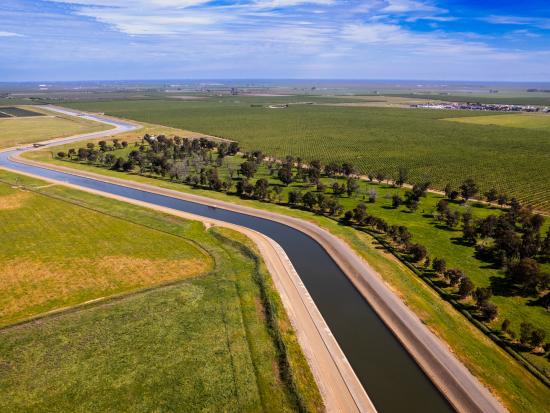The Department of the Interior announced a $19 million investment to install solar panels over irrigation canals in California, Oregon and Utah, simultaneously decreasing evaporation of critical water supplies and advancing clean energy goals.
Principal Deputy Assistant Secretary for Water and Science Michael Brain and Bureau of Reclamation Commissioner Camille Calimlim Touton made the announcement alongside state and local officials at the Delta-Mendota Canal floating solar project, set to receive $15 million.
Installing solar panels in irrigation canals has the potential to provide a variety of benefits, including:
–Generating renewable energy;
–Reducing evaporation losses of the canal;
–Increasing efficiency of and production from solar panels because of the cooling effect of the water beneath the panels;
–Creating land savings for open space and agricultural use;
–Reducing facility maintenance by mitigating algae and/or aquatic plant growth; and
–Reducing the energy footprint and carbon emissions required to operate and maintain the facility.
The projects in California, Oregon and Utah are part of an initiative to study the water efficiency gains and amount of clean energy produced for future larger scale implementation. They are being funded by the Inflation Reduction Act, which makes available $25 million for the design, study and implementation of projects to cover Reclamation-related water conveyance facilities with solar panels.
The projects announced today include:
–$15 million for the San Luis and Delta-Mendota Water Authority, Delta-Mendota Canal Floating Solar Project in California: The San Luis and Delta-Mendota Water Authority, Reclamation and the University of California-Merced will collaborate through a public-private-academic partnership to assess the impacts of floating photovoltaic solar arrays on the Delta-Mendota Canal. The pilot intends to deploy potentially up to three floating solar technologies to assess the viability, costs, and benefits of floating solar over canal technologies on large conveyance facilities like the Delta-Mendota Canal. The initiative will also validate floating photovoltaics design for moving water, identify and address issues related to maintaining a canal with panels on it, explore the power generation potential, and develop methods to quantify impacts on water quality.
–$2.55 million for the North Unit Irrigation District, Main Canal Floating Photovoltaics Project in Oregon: The North Unit Irrigation District will construct floating photovoltaic solar panels on the Main Canal of the Deschutes Project. The project will evaluate the impact of floating solar panels on water efficiency gains and amount of clean energy produced.
–$1.5 million for the Weber Basin Water Conservancy District, Solar Panels Over the Layton Canal Project in Utah: The Weber Basin Water Conservancy District will cover existing canals with canal-spanning solar panel structures in the upper portion of the Layton Canal. The project will serve as a five-year demonstration of data collection and monitoring to evaluate the technical capability, economic feasibility, and viability for full scale implementation for both Reclamation and the district. The project expects to increase water quality by reducing algal blooms along the canal, produce renewable energy to offset pump station use or sell back to the utility, and significantly reduce water loss to evaporation.
The announcement builds on the $5.65 million announced for the Gila River Indian Community in Arizona to construct and install solar panels over the Casa Blanca Canal.
“Through President Biden’s Investing in America agenda, we have historic new resources to invest in innovative solutions that advance our clean energy goals and make Western communities more resilient to drought and climate change,” said Brain. “In partnership with state, Tribal and local stakeholders, the Interior Department will continue to invest in essential water infrastructure projects that mitigate the worst impacts of climate change and invest in communities across the country.”
“As with so much of our work, Reclamation could not achieve our mission without the valuable engagement of our partners,” said Touton. “We look forward to working collaboratively on this novel idea to conserve water and generate renewable energy with funding from President Biden’s Investing in America agenda. These projects will help inform similar projects to better understand their impacts and make that information publicly available so that we can all understand the scale and corresponding benefits they provide.”
Through the Infrastructure Law, Reclamation is also investing $8.3 billion over five years for water infrastructure projects, including rural water, water storage, conservation and conveyance, nature-based solutions, dam safety, water purification and reuse, and desalination. Over the first two years of its implementation, Reclamation has allocated nearly $3 billion for 425 projects.
This funding is also advancing Biden’s Justice40 Initiative, which aims to ensure that 40 percent of the overall benefits of certain climate, clean energy, and other federal investments flow to disadvantaged communities marginalized by underinvestment and overburdened by pollution.

